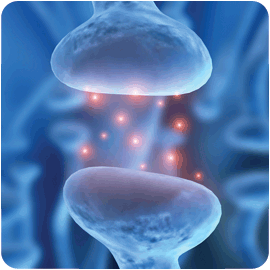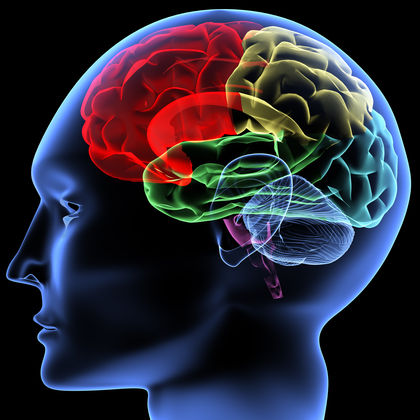What are Neurotransmitters? How do they
affect your life?
This is all good information, but exactly what are
neurotransmitters?
Just like hormones
govern many chemical functions in the body, the brain's chemical functions are
governed by messengers called neurotransmitters.
 |
| Fig. Neurosynaptic transmission |
A neurotransmitter is a chemical messenger used by neurons (nerve
cells) to communicate in one direction with other neurons. These
neurotransmitters are either excitatory or inhibitory. Each cell receives its
instructions through nerve processes called dendrites and it passes on
instructions to the next cell through its axon. The gap between the axon of one
cell and the dendrite of the next is called a synapse.
Special molecules in the dendrite are called receptors. They are
shaped to receive only one type of neurotransmitter, which fits it like a key
in a lock. The result is that if an excitatory
neurotransmitter reaches the specific receptor, the cell tends to fire. If an inhibitory neurotransmitter reaches the receptor, the cell does not fire.
neurotransmitter reaches the specific receptor, the cell tends to fire. If an inhibitory neurotransmitter reaches the receptor, the cell does not fire.
If neurotransmitters of either type are in short supply, or if
they are blocked from reaching their proper receptors, (as a result of either
genetics and/or chemical use) cell function tends to be abnormal. The lack of
neurotransmitter function then results in maladaptive behavior.
The human brain is very capable of automatically manufacturing the
quantity of chemicals it needs IF it is given the raw materials (nutrients from
foods) to do so. However, normal diet does not supply enough of the raw
materials the brain needs to manufacture the needed level of neurotransmitters.
Additionally, stress, worry, chemical use, poor nutrition, pollution and other
factors of modern life are known to deplete neurotransmitter levels.
In order to ingest the required amount of food to provide the
necessary amount of amino acids needed to maintain normal neurotransmitter
levels we would have to eat each day:
- Several pounds of fish
- Gallons of whole milk,
- Platters of cheese and turkey
Not only is this impractical it is impossible, so therefore
another source of nutritional support is necessary so we do not gain hundreds
of pounds.
Next we will look at a few of the more familiar neurotransmitters
and their function.
Neurotransmitter Functions
Neurotransmitters are
the chemicals that allow communication to occur in the brain. Different neurotransmitters
allow and/or produce different functions. We can link various thinking, feeling
and behavioral actions and states to various transmitters.
We discussed earlier there is a balance of these
neurotransmitters. What happens if we become deficient or have too much of one
or more of these? What causes these interruptions to the natural balance? How
can we compensate and help our body rebuild and rebalance?
Transmitter Molecule
|
Transmitter Class
|
Derived from
|
Receptors / Activities /
Comments
|
Acetylcholine
|
Choline
|
functions
in both the CNS and the PNS; receptors are cholinergic; 2 receptor classes:
muscarinic (metabotropic) and nicotinic (ionotropic); within the periphery
ACh is the major transmitter of the autonomic nervous system where it
activates muscles; within the brain its major effects are inhibitory or
anti-excitatory; its actions in cardiac tissue are also inhibitory
|
|
GABA
|
amino acid
|
Glutamate
|
major
inhibitory neurotransmitter in the CNS; also exerts effects in the periphery;
binds to two classes of receptor termed GABAA (ionotropic)
and GABAB(metabotropic)
|
Glutamate
|
amino acid
|
most
abundant excitatory neurotransmitter in the CNS; glutamate binds to the
metabotropic glutamate receptors (mGluRs) of which there are eight (mGluR1–mGluR8)
divided into three families; glutamate also binds to several ionotropic
receptors including the N-methyl-D-asparatate (NMDA) receptor
(NMDAR), the kainate receptors (KAR), and the
α-amino-3-hydroxy-5-methyl-4-isoxazolepropionic acid (AMPA) receptor (AMPAR)
|
|
Aspartate
|
amino acid
|
stimulates
the NMDA receptor but not as strongly as glutamate
|
|
Glycine
|
amino acid
|
inhibitory
neurotransmitter in the CNS primarily within the brainstem, spinal cord, and
retina; binds to glycine receptors (GlyR) which are ionotropic; there are two
separate subunit proteins of each GlyR (α and β) that combine in various ways
to generate a pentameric structure; there are four α-subunit genes (α1–4)
and one β-subunit gene; the primary adult form of GlyR is composed of three α1 subunits
and two β subunits; is also a required co-agonist with glutamate on NMDA
receptors and in this capacity exerts an excitatory effect
|
|
Histamine
|
diamine
|
histidine
|
produced
by mast cells, basophils, enterochromaffin-like cells (ECL) of the stomach,
and hypothalamus; within the gut histamine stimulates gastric parietal cells
to secrete acid; released from mast cells when allergens bind to IgE-antibody
complexes; there are four histamine receptors (H1–H4) all of which are GPCRs
|
Serotonin
5-hydroxytryptamine (5-HT) |
monoamine
|
tryptophan
|
most
abundantly expressed in enterochromaffin cells of the gut where it regulates
motility, also found in the CNS and platelets; released from activated
platelets where it stimulates further activation propagating role of platelet
aggregation in coagulation; in the CNS 5-HT regulates mood, appetite,
sleep, memory and learning; selective serotonin re-uptake inhibitors (SSRIs)
used in the treatment of depression
|
Epinephrine
synthesis pathway |
monoamine
|
tyrosine
|
catecholamine
neurotransmitter and hormone; binds to both α- and β-adrenergic receptors
(GPCRs); produced in the adrenal medulla and some CNS cells; primary hormone
of the fight-or-flight response of the sympathetic nervous system; is a major
regulator of metabolic processes in numerous tissues; regulates heart rate,
induces vascoconstriction and bronchodilation
|
Norepinephrine
synthesis pathway |
monoamine
|
tyrosine
|
catecholamine
neurotransmitter and hormone; binds to both α- and β-adrenergic receptors
(GPCRs); produced in CNS by sympathetic nerves; major neurotransmitter
function is in regulation of cardiac chronotropic (rate) function; functions
along with epinephrine in the fight-or-flight response; involved in adaptive
thermogenesis in brown adipose tissue (BAT)
|
Dopamine
synthesis pathway |
monoamine
|
tyrosine
|
within
the CNS dopamine plays a major role in reward-motivated behavior such as
feeding and drug-seeking behaviors; also involved in motor control; in the
periphery dopamine regulates the release of several hormones such as insulin
from the pancreas and norepinephrine from blood vessels; functions by binding
to a family of dopaminergic receptors (GPCRs)
|
Adenosine
|
other
|
ATP
|
is
an inhibitory neurotransmitter within the CNS, suppresses arousal thus
promoting sleep; within the periphery adenosine exerts anti-inflammatory
actions, induces bronchospasm in the lungs, and within the heart where it
affects the cardiac conduciton system; adenosine binds to a family of
adenosine receptors (GPCRs) identified as A1, A2A, A2B,
and A3
|
ATP
|
other
|
as
a neurotransmitter ATP is released from sympathetic, sensory and enteric
nerves; binds to P2Y12 which is a member of the purinergic
family of GPCRs (metabotropic receptors of which there are 12 genes in
humans: P2Y1, 2, 4, 5, 6, 8, 9, 10, 11, 12, 13, 14; P2Y12 is
primarily expressed on the surface of platelets; also binds to the ionotropic
family of purinergic receptors (P2X) which consists of seven members (P2X1–7);
these receptors modulate synaptic transmission throughout the CNS, PNS, and
autonomic nervous system; in the periphery the P2X receptors activate
contractile activity of various muscle types
|
|
Nitric oxide, NO
|
gas
|
arginine
|
endothelial
cells, phagocytic cells, CNS, gastrointestinal tract; binds to and activates
soluble guanylate cyclase, oxidizes iron-containing proteins, nitrosylates
protein sulfhydryl groups
|
Neurotransmitters are
small molecules whose function is to transmit nerve signals (impulses) from one
nerve cell (neuron) to another. Neurotransmitters are chemical messengers which
neurons use to tell other neurons that they have received an impulse. There are
many different neurotransmitters - some trigger the receiving neuron to send an
impulse and some stop it from doing so.
See this simplified diagram of a neuron:
 |
| Fig. Neurons (Courtesy : http://www.victorie-inc.us) |
Nerve impulses always flow in one direction - from the branched
extensions called dendrites, down the neuron to the presynaptic
terminals. The join between the presynaptic terminals of one neuron and the
dendrites of another is called the synapse. The two neurons do not actually
touch each other but are separated by a space called the synaptic cleft. When a
nerve impulse arrives at a presynaptic terminal it causes neurotransmitters to
be released into the synaptic cleft. The neurotransmitters then bind with
special "postsynaptic receptors" in the dendrites of the receiving
neuron. When a postsynaptic receptor receives a neurotransmitter it can either
cause a nerve impulse to travel down the neuron or it can inhibit a nerve
impulse depending on the neurotransmitter released.
Neurotransmitters which propagate nerve impulses in the receiving
neuron are called excitatory neurotransmitters. Those which inhibit nerve
impulses are called inhibitory neurotransmitters.
Neurotransmitters are sythesized in the cell body (the soma) and
migrate down the axon to the presynaptic terminals. Here they are stored in
little packets called vesicles which fuse with the synaptic membrane. When a
depolarizing current (the action potential) is received, these vesicles release
their contents into the synaptic cleft.
Many different substances effect the transmission of nerve
impulses across the synapse and many of these are falsely called
neurotransmitters. To be a neurotransmitter a substance must:
- be synthezised within neurons
- be released from the
presynaptic terminal in response to an action potential (essentially a
nerve impulse).
- cause a biological effect in
the postsynaptic receptors.
- a mechanism must exist to
inactivate or remove the transmitter from the receptor
Neurotransmitters activate receptors by "sticking" to
them and thus preventing other neurotransmitters from activating them.
Inactivation of the transmitter happens in one of three ways:
- reabsorption of the
neurotransmitter into the neuron. This is known as reuptake and is the
normal process.
- destruction of the
neurotransmitter with special chemicals called enzymes. This is known as
enzymatic degradation.
- by the neurotransmitter
becoming deteched from the receptor and drifting out of the synaptic
cleft. This is known as diffusion.
Substances that effect neurotransmission but are not
neurotransmitters can be broadly divided into two categories - agonists and
antagonists. Agonists make transmission of nerve impulses more likely. They do
this in a number of ways including preventing reuptake (cocaine works this
way), actually triggering the receptor themselves (nicotine works this way) and
by making the receptor more responsive (a lot of anti-anxiety drugs work like
this). Antagonists do the opposite - they interfere with nerve transmission
across the synapse sometimes by blocking receptor sites (many spider and snake
venoms work this way) and sometimes by preventing release of the
neurotransmitter from the presynaptic terminal (many anti-psychotic drugs
operate like this).


No comments:
Post a Comment